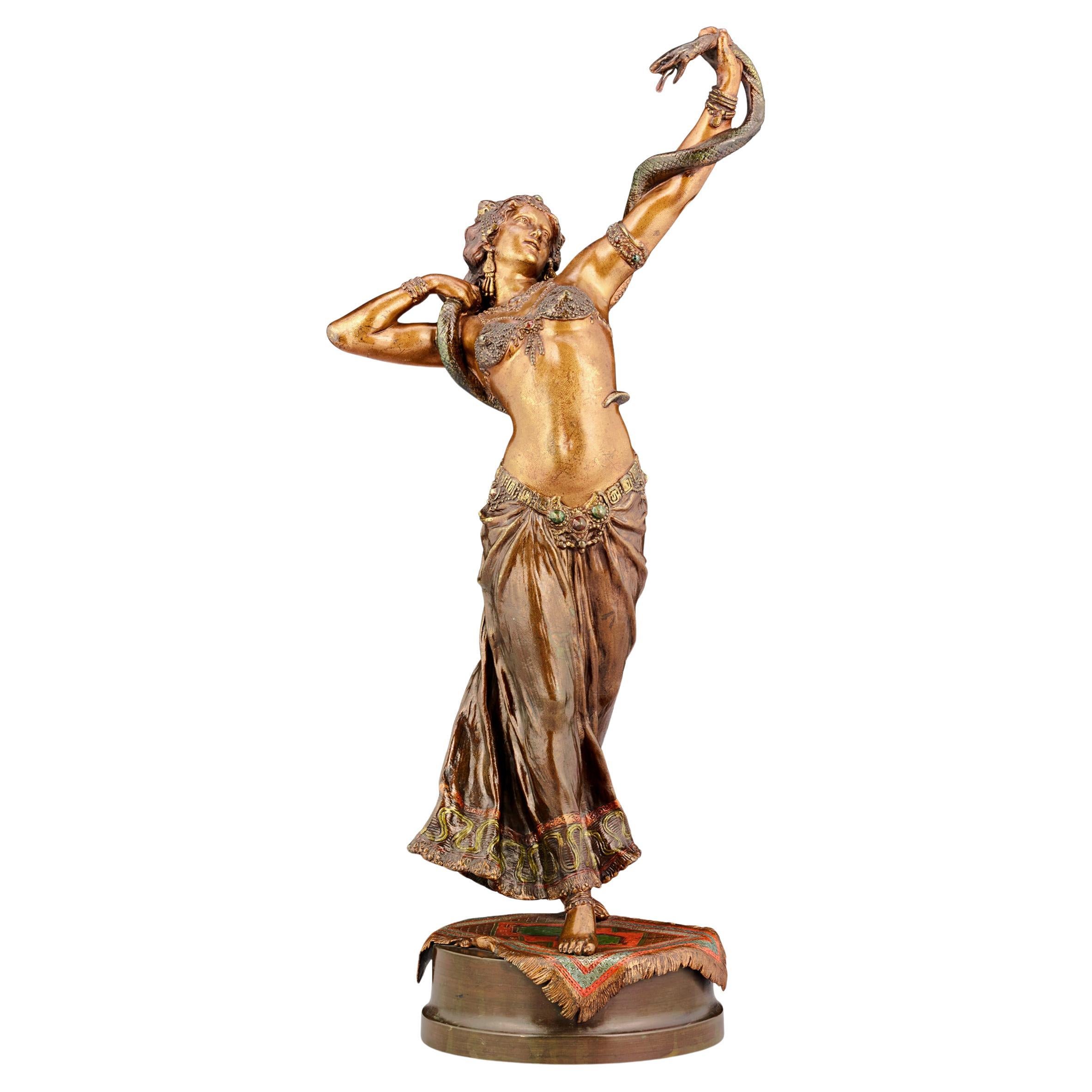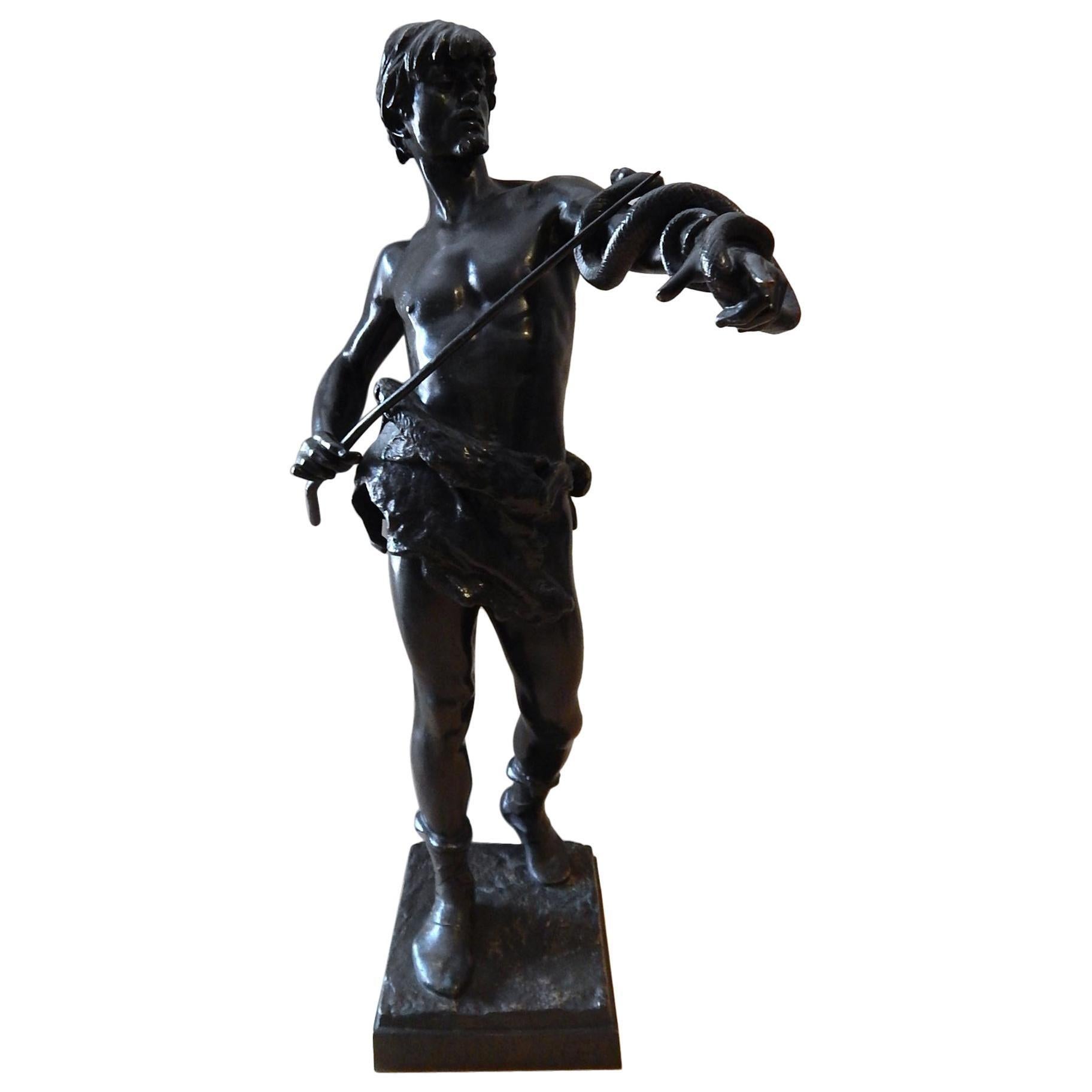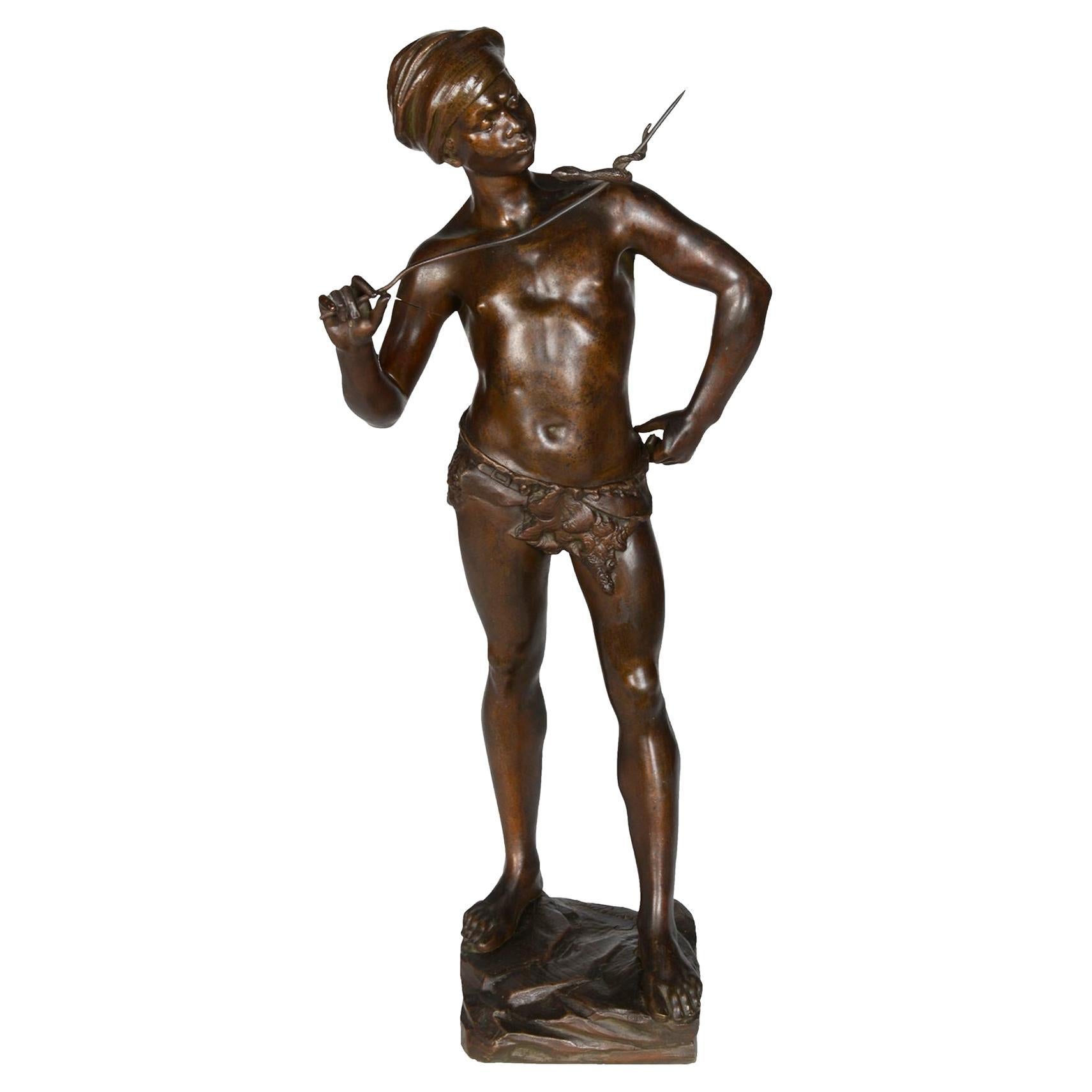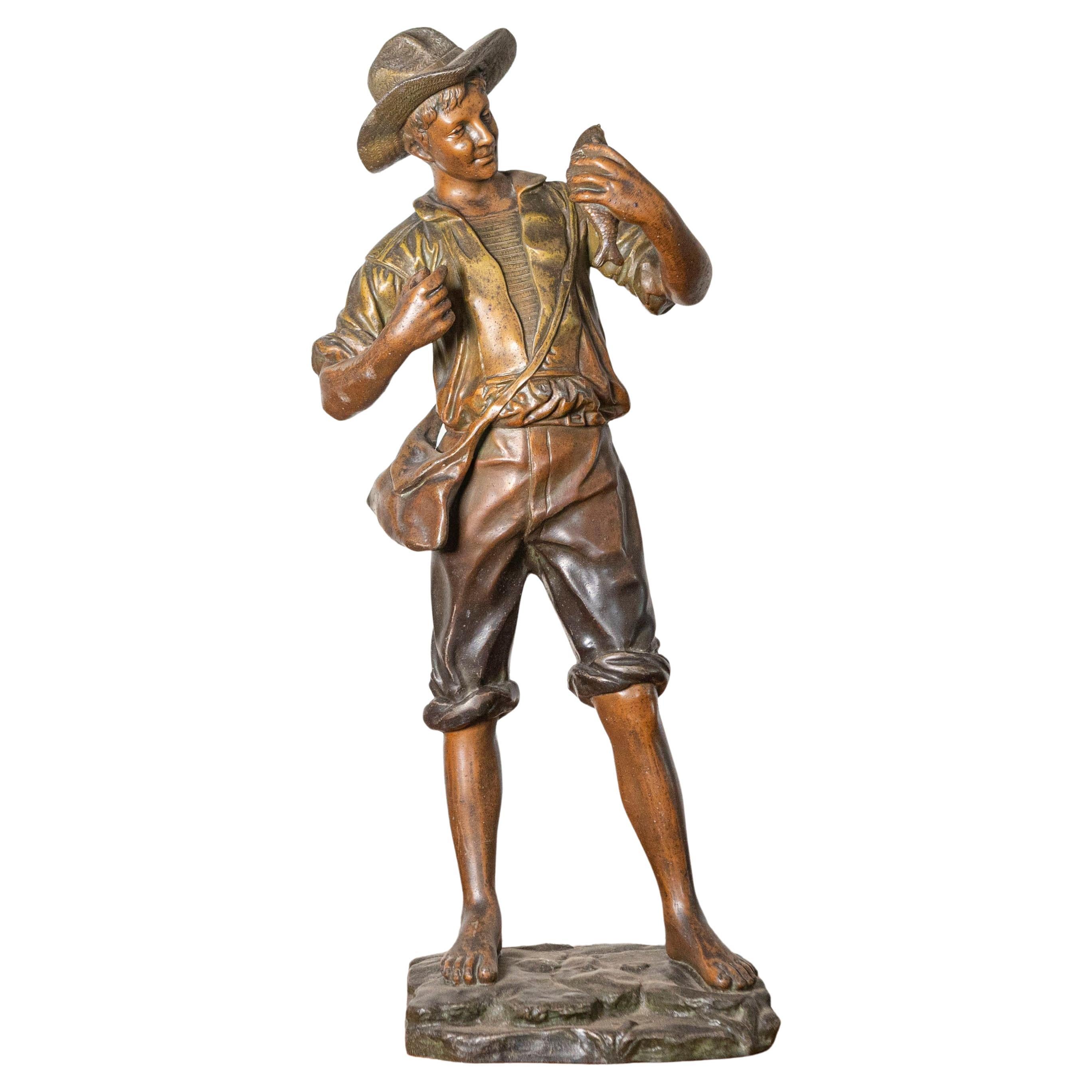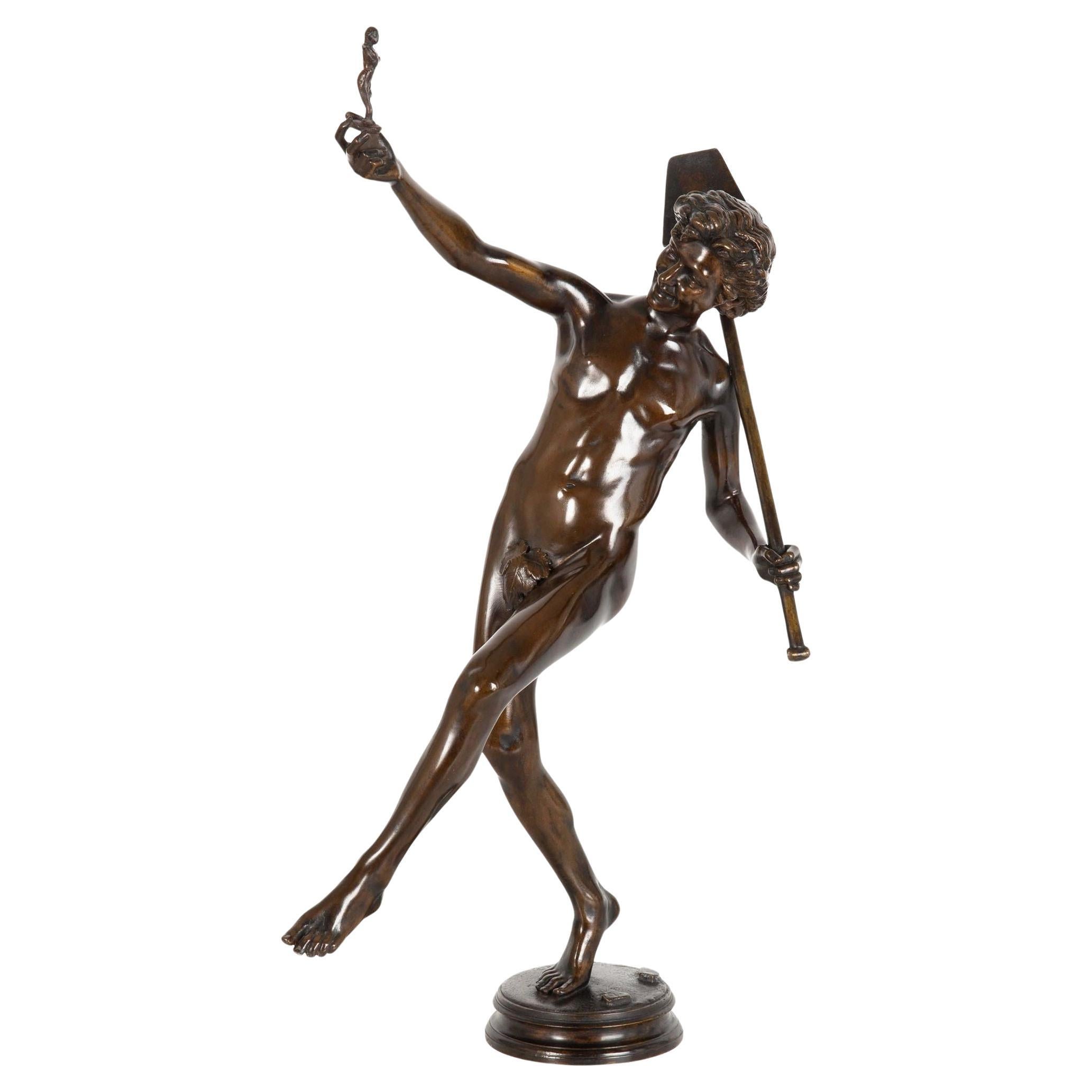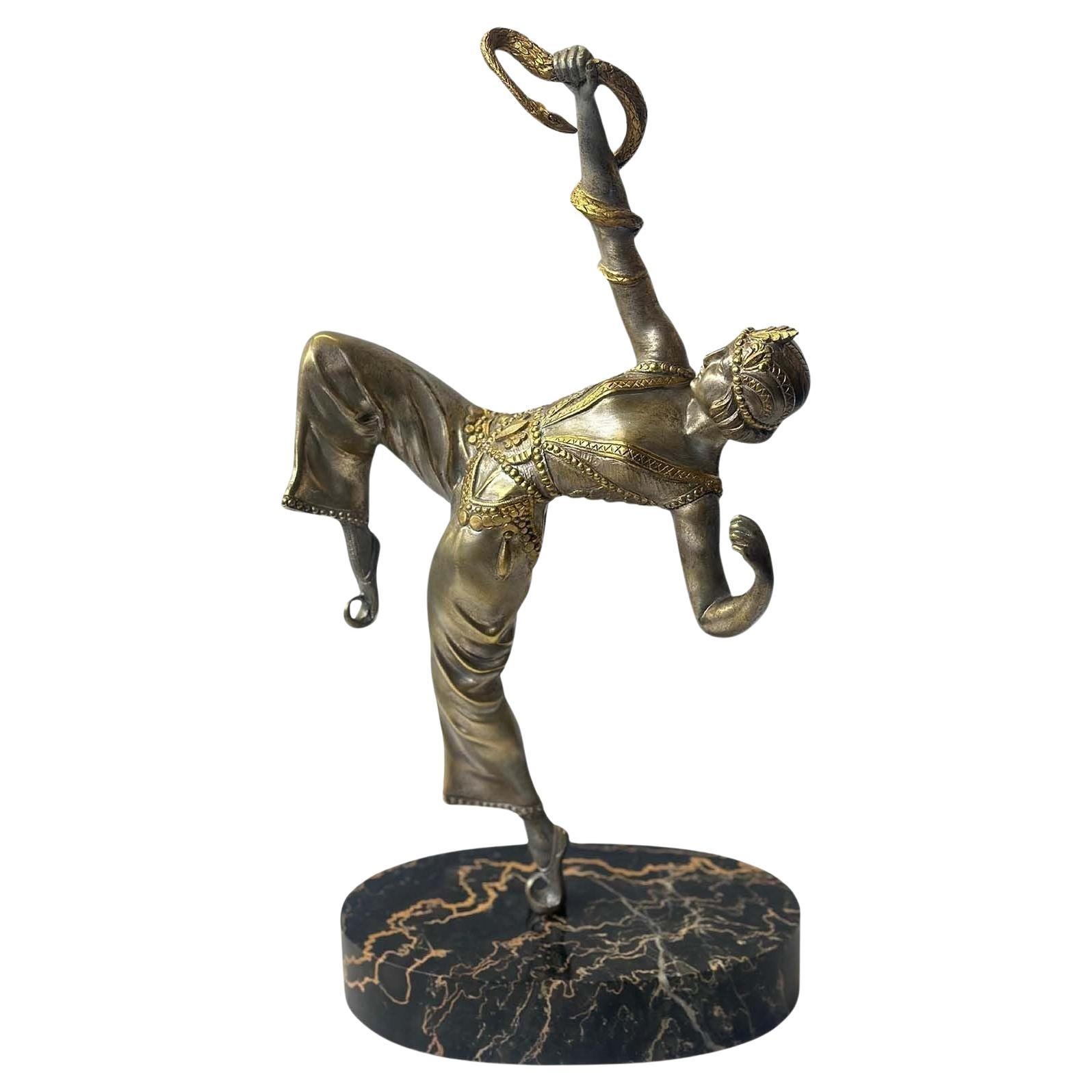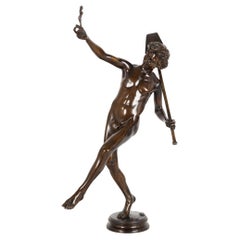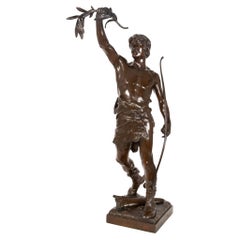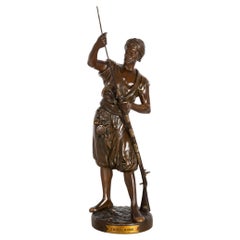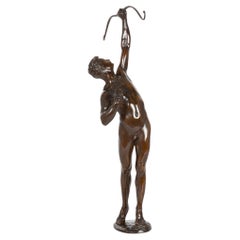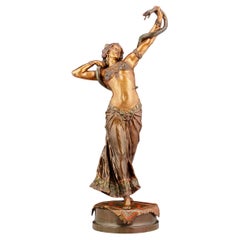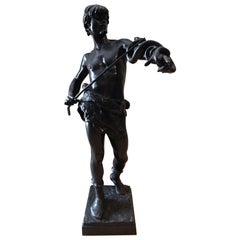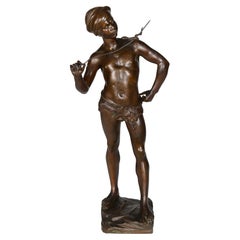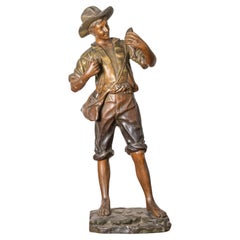Items Similar to Rare British Bronze Sculpture “Snake Charmer” (1876) by Sir Thomas Brock
Want more images or videos?
Request additional images or videos from the seller
1 of 21
Rare British Bronze Sculpture “Snake Charmer” (1876) by Sir Thomas Brock
$16,500
£12,452.10
€14,255.77
CA$23,270.47
A$25,548.07
CHF 13,328.48
MX$309,167.27
NOK 167,051.87
SEK 157,406.78
DKK 106,415.50
About the Item
SIR THOMAS BROCK R.A.
British, 1847-1922
"Snake Charmer" (1876)
Sand-cast and patinated bronze Unsigned, chiseled foundry mark for COX & SONS FOUNDERS cast circa 1880
Item # 409RKP23G
Exhibited at the 1876 Centennial International Exhibition in Philadelphia by the foundry Cox & Sons, at the Royal Academy in 1877 (no. 1459) and at The Royal Glasgow Institute of the Fine Arts in 1879, Snake Charmer is one of Thomas Brock's earliest Ideal subjects before he became slowly immersed in the New Sculpture movement in Britain.
Brock's open-minded approach to modeling and an eagerness to break away from tradition is perhaps best showcased in this early model. Eschewing the Rome School approach to classicism, glory and heroism, Brock infuses an emotional association in his Snake Charmer that is highly refreshing. It has an almost spiritual and ethereal quality, the seated mystic dressed only in a simple pair of woven shorts while he props his leg on the crisply woven basket from which his serpent most likely appeared. He raises the writhing snake into the air on a thin reed while loosely holding his flute between his fingers in the other hand.
The modeling is extraordinary and the casting quality is superb, the surface being very finely finished in a medium and dark brown translucent patina. It is unsigned and is only marked by COX & SONS FOUNDERS on the vertical edge of the base.
A most scarce model.
SIR THOMAS BROCK R.A.
Thomas Brock was a prominent British sculptor who achieved fame in his day for his many important public monuments, most notably his monument to Queen Victoria. He specialized in portrait sculptures and is remembered for his significant contributions to the New Sculpture movement.
Born in Worcester in 1847, Brock began his artistic training as an apprentice at Worscester Royal Porcelain where he did modeling for their ceramic work while studying at the Government School of Design in Worcester before moving to London to study at the Royal Academy Schools. Here he studied under John Henry Foley starting in 1866, one of the leading academic sculptors of the time and a figure that would have a significant influence on his modeling. He enrolled at the Royal Academy School in 1868 and in 1869 he had won a gold medal for "Hercules Strangling Antaeus".
This exhibit caught the attention of Lord Frederic Leighton, the highly influential painter and sculptor, and would lead to a lifelong friendship that had no small influence on the shape his career took. Leighton served as a mentor to Brock, guiding him in both artistic technique and professional development. His emphasis on naturalism, dynamism and truth-telling in sculpture led Brock to become a part of the New Sculpture movement in London, refocusing his modeling on empathy, fluid movement and a carefully observed connection with his subjects.
Brock's reputation and position in the sculptor community was firmly secured with his completion of the monumental statue of Prince Albert for the Albert Memorial. In 1876 he won another gold medal at the Royal Academy.
His early work was firmly rooted in the classical tradition with a firm rooting in his academic training. As his eye matured and he became more in tune with the essence of the New Sculpture movement, his handling of subjects evolved to create a more dynamic image, expressive and sympathetic to the true nature of the topic. This movement, which emerged in the 1880s, aimed to bring sculpture closer to life through more fluid poses and a greater sense of realism. Brock embraced these ideas, particularly in his treatment of the human form, while still maintaining the precision and attention to detail for which he was known.
Among his most notable works are "Moment of Peril" in the Leighton House Garden, the "Statue of Queen Victoria" unveiled in 1911, "Eve" (1898) and the Royal Artillery Memorial at Hyde Park Corner (1925). Brock was also well-known for his portrait busts, which not only capture the form and features of his sitters but also their character and personality.
Brock's style evolved over his career, incorporating elements of the New Sculpture movement without abandoning his classical training. He focused on creating sculptures that were both technically masterful and emotionally resonant, embodying the values of dignity and heroism in his public monuments. He was elected a full member of the Royal Academy in 1897 and remained a respected figure in British art throughout his life.
Today, his works continue to be held in major collections, including the National Portrait Gallery, the Tate Collection, the Royal Academy of Arts and the Victoria and Albert Museum.
COX & SONS
Originally founded as a firm of clerical tailors in 1838 by Thomas Cox, the firm became known as Cox & Son in 1853 and Cox & Sons in 1868. They took place in London's 1856 Architectural Exhibition with machine carved examples and advertised as "Church Furnishers" in 1859, highlighting their stained glass production. They began producing carved woodworks for domestic households, expanding their market beyond clerical and church furnishings. They participated in the 1862 International Exhibition in London, showing furniture, decorative objects and many carved goods that were included in the company's catalog. By 1871 they were known as maker's of cabinet and artistic furniture as well as Patent Carving Works.
Starting in 1874, Cox & Sons built a highly specialized foundry at Thames Ditton in Surrey with a hand-operated gantry lift that could raise or lower the warehouse floor for monumental sculpture. Despite being sold to M.J.C Buckley and A.S. Thomson in 1880, becoming Cox, Sons, Buckley & Co, they continued to operate under the name Cox & Sons and were recorded in the Classified List of Furniture, Upholstery and Allied Trades (1886) as "Cox & Sons". In 1897 the foundry was acquired by Arthur Bryan Burton who had apprenticed in the foundry of Cox & Sons when he was sixteen. It thereafter took on Burton's name through its closure in 1933. (Source: The Furniture History Society: British and Irish Furniture Makers: Cox & Son(s); Cox, Sons, Buckley & Company 1853-1935)
Artist Listings & Bibliography:
The New Sculpture, Beattie, 1983, extensive discussion of Brock throughout the text in the context of the other elements of the movement, biography p. 241
"A Dictionary of Exhibitors at the Annual Exhibitions of the Royal Glasgow Institute of the Fine Arts, The Royal Glasgow Institute of the Fine Arts, 1861-1989"
The Royal Academy of Arts; a Complete Dictionary of Contributors and their Work from its Foundation in 1769 to 1904, Graves, 1970, p. 290
E. Benezit Dictionary of Artists, vol. II, Gründ, 2006, p. 1276
Nineteenth-Century Romantic Bronzes: French, English and American Bronzes 1830-1915, Cooper, 1975
Measurements: 42 1/8" H x 14" D x 17 1/2" W
Provenance: Private US collection - acquired from a collection in the United Kingdom in the 1930s while serving as an officer in the US Navy during World War I and World War II.
Condition Report:
Very fine condition, carefully cleaned and sealed in conservator's wax. Trace wear to elements throughout, some rubbing to the patina of his back, a small scratch to his thigh. Rubbing wear and loss to the lacquered-gilt patina of the flute. Flute and hand have some rubbing where the flute moved back and forth against his palm - the flute was affixed to his palm with a tiny pin, a carefully executed renovation to eliminate further rubbing wear. Other minor scuffs and surface history. An exquisite presentation, ready to place.
About silla antiques & art
Established in 2009, we have available in our 9000 square foot brick-and-mortar gallery an ever-changing selection of carefully curated and catalogued furniture, decorative arts, paintings, sculpture and estate jewelry. Our company has long specialized in sculpture circa 1860 through 1930 and as such the gallery always has a very large collection of exceptional European and American sculpture available on display.
The gallery is located at 117 W Burd Street in Shippensburg, Pennsylvania and is open by appointment only. We welcome your visit and would love to meet with you at the shop. For clients located outside of the area, we are always available to discuss items by video conferencing or by phone.
- Dimensions:Height: 42.13 in (107.02 cm)Width: 17.5 in (44.45 cm)Depth: 14 in (35.56 cm)
- Style:Romantic (Of the Period)
- Materials and Techniques:
- Place of Origin:
- Period:
- Date of Manufacture:1880
- Condition:Repaired: See condition notes.
- Seller Location:Shippensburg, PA
- Reference Number:Seller: 409RKP23G1stDibs: LU1059043206102
About the Seller
4.9
Recognized Seller
These prestigious sellers are industry leaders and represent the highest echelon for item quality and design.
Platinum Seller
Premium sellers with a 4.7+ rating and 24-hour response times
Established in 2009
1stDibs seller since 2014
515 sales on 1stDibs
Typical response time: 1 hour
- ShippingRetrieving quote...Shipping from: Shippensburg, PA
- Return Policy
Authenticity Guarantee
In the unlikely event there’s an issue with an item’s authenticity, contact us within 1 year for a full refund. DetailsMoney-Back Guarantee
If your item is not as described, is damaged in transit, or does not arrive, contact us within 7 days for a full refund. Details24-Hour Cancellation
You have a 24-hour grace period in which to reconsider your purchase, with no questions asked.Vetted Professional Sellers
Our world-class sellers must adhere to strict standards for service and quality, maintaining the integrity of our listings.Price-Match Guarantee
If you find that a seller listed the same item for a lower price elsewhere, we’ll match it.Trusted Global Delivery
Our best-in-class carrier network provides specialized shipping options worldwide, including custom delivery.More From This Seller
View All1880s French Antique Bronze Sculpture “Find in Pompeii!” by Hippolyte Moulin
By Thiebaut Freres
Located in Shippensburg, PA
HIPPOLYTE ALEXANDRE JULIEN MOULIN
French, 1832-1884
"Une Trouvaille à Pompéi" (A Find in Pompeii)
Sand-cast and patinated bronze Signed on base "Moulin", sealed with foundry cache...
Category
Antique 19th Century French Romantic Figurative Sculptures
Materials
Bronze
Large 36” French Bronze Sculpture of Warrior “Vainqueur” by Eugene Marioton
By Eugene Marioton
Located in Shippensburg, PA
EUGENE MARIOTON
French, 1857-1933
"Vainqueur"
Dark-brown patinated bronze signed "E. Marioton", foundry cachet for Siot-Decauville, cold-stamped D718 cast circa 1910
stock ref. ...
Category
20th Century French Romantic Figurative Sculptures
Materials
Bronze
Rare French Orientalist Bronze Sculpture Arab Warrior after Jean Didier Debut
By Jean Didier Debut
Located in Shippensburg, PA
JEAN-DIDIER DEBUT
French, 1824-1893
French Orientalist Model of a Janissaire Warrior
Polychromed and patinated bronze signed "E. Debut", sealed with editeur cachet "Bronze Ga...
Category
20th Century French Figurative Sculptures
Materials
Bronze
German Bronze Sculpture of “Hercules & Stymphalian Birds” by Joseph Uphues
By Gladenbeck Foundry
Located in Shippensburg, PA
A fluid and sinuous depiction of Hercules the moment after releasing an arrow from his bow to kill the Stymphalian birds, it was one of Joseph Uphues'...
Category
20th Century German Figurative Sculptures
Materials
Bronze
Art Deco Period Bronze Sculpture “Flute Player” by Paul Philippe
Located in Shippensburg, PA
An exquisitely cast example of Paul Philippe's The Flute Player, it was cast circa 1920 and features a wonderful allover gilt and pigment polychromed ...
Category
20th Century French Art Deco Figurative Sculptures
Materials
Marble, Bronze
French Orientalist Bronze Sculpture of Tunisian Fruit Seller by Marcel Debut
By Marcel Debut
Located in Shippensburg, PA
MARCEL DEBUT
French, 1865-1933
French Orientalist Model of a Young Boy Selling Fruit
Polychromed and patinated bronze signed "Debut", sealed with editeur cachet "Bronze Garanti Au T...
Category
Early 20th Century French Figurative Sculptures
Materials
Bronze
You May Also Like
Bronze Snake Charmer by Franz Bergman
By Franz Bergmann
Located in New Orleans, LA
Bronze Statue of a Snake Charmer
Franz Bergman
Early 20th Century
This captivating cold-painted bronze sculpture of a snake charmer is the work of the renowned Austrian sculptor Fra...
Category
Early 20th Century Austrian Figurative Sculptures
Materials
Bronze
Eugene Marioton French Bronze, circa 1890s, “Fascinator” Snake Charmer
By Eugene Marioton
Located in Phoenix, AZ
Bronze by Eugene Marioton (1857-1933) French Artist. “Fascinator” (Snake Charmer), created late 19th century
Sculpture measures 20 1/2" H x 9" L x 9 1/2" W. Siot Decauville Foundry -...
Category
Late 19th Century Figurative Sculptures
Materials
Bronze
Bronze Arab boy snake charmer, 19th Century
Located in Brighton, Sussex
An enchanting 19th Century French Arab patinated bronzes boy snake charmer, circa 1880.
Batch 74
Category
Antique 19th Century French Sculptures and Carvings
Materials
Bronze
19th Century French Bronze Sculpture
Located in Atlanta, GA
This exquisite 19th-century French bronze sculpture captures the essence of rural life through the figure of a young peasant boy. The boy is depicted with a charming, rustic appeal,...
Category
Antique 19th Century Italian Figurative Sculptures
Materials
Metal, Bronze
Art Deco Snake Charmer Bronze Sculpture by S. Lipchytz
By Samuel Lipchytz
Located in Los Angeles, CA
French Art Deco patinated bronze sculpture of a snake charmer orientalist dancer holding an alluring pose, while having a snake wrapped around her arm. It is standing on an oval blac...
Category
Vintage 1920s French Figurative Sculptures
Materials
Marble, Bronze
Antique bronze sculpture of Aladdin and the magic lamp by Marcel Debut
By Marcel Debut
Located in Antwerp, BE
Antique bronze sculpture of Aladdin and the magic lamp by Marcel Debut. Impressive size, France ca. 1900.
Literature:
Bronzes, sculptors and founders by H...
Category
Antique Early 1900s French Belle Époque Figurative Sculptures
Materials
Bronze
More Ways To Browse
Exhibition 1862
Antique Props
Centennial 1876
19th Century European Still Life Paintings
Maker And Son
Rome Model
Cox And Sons
Queen Victoria Portrait
Victoria And Son
Wedgwood Medallion
Wood Dummy
Antique Lay Figure
Antique Phallus
Antique Tomahawks
Antique Wooden Fruit
Arab Camel
Art Deco Royal Dux
Art Nouveau Mermaid
